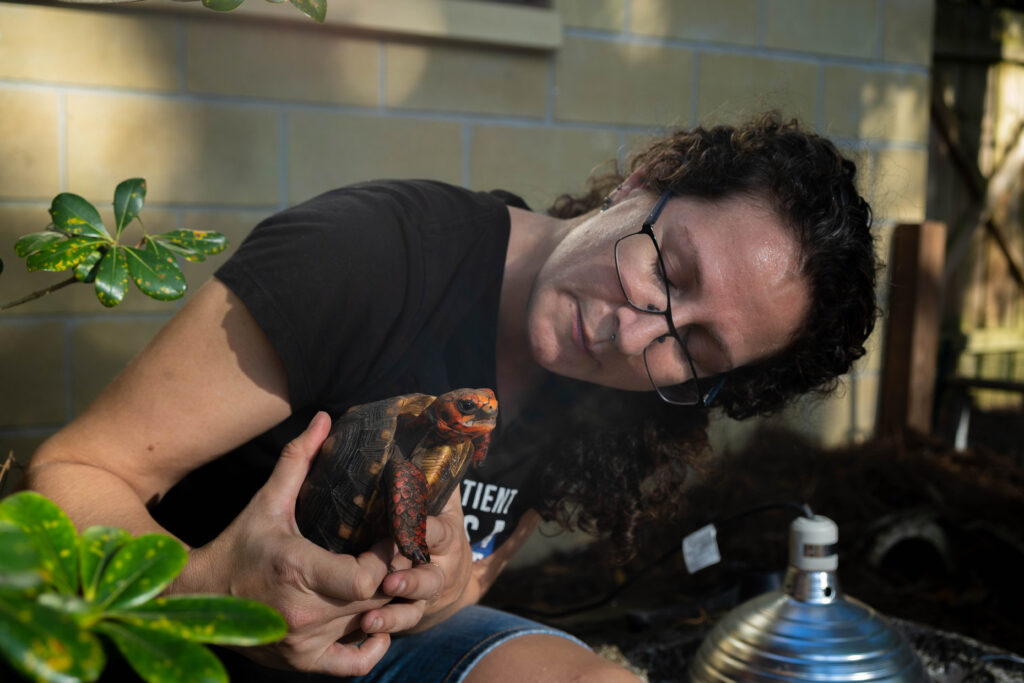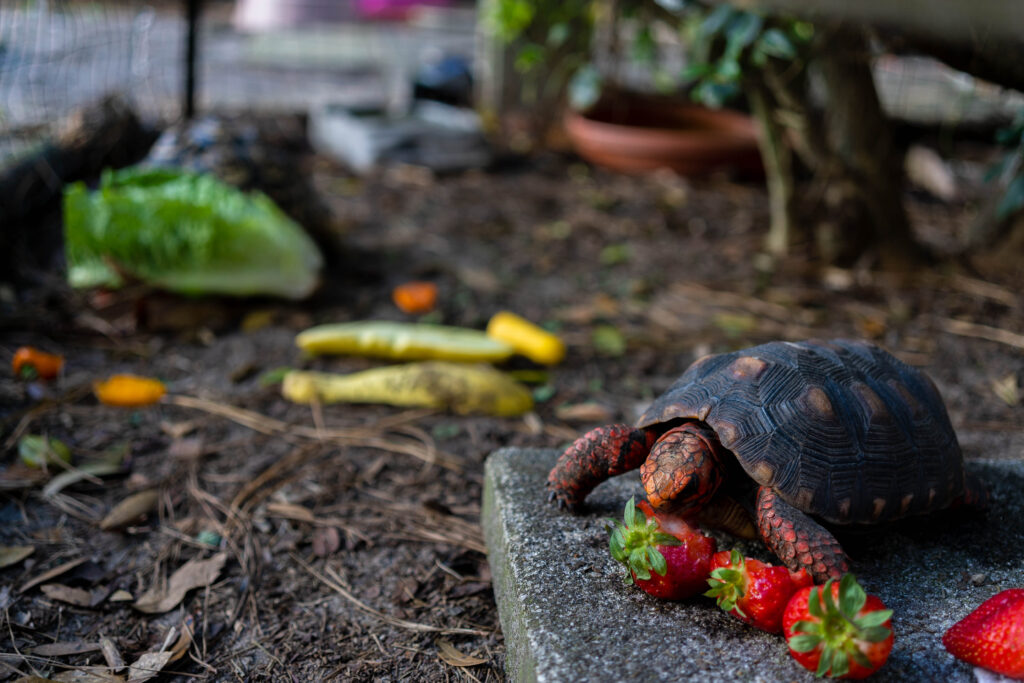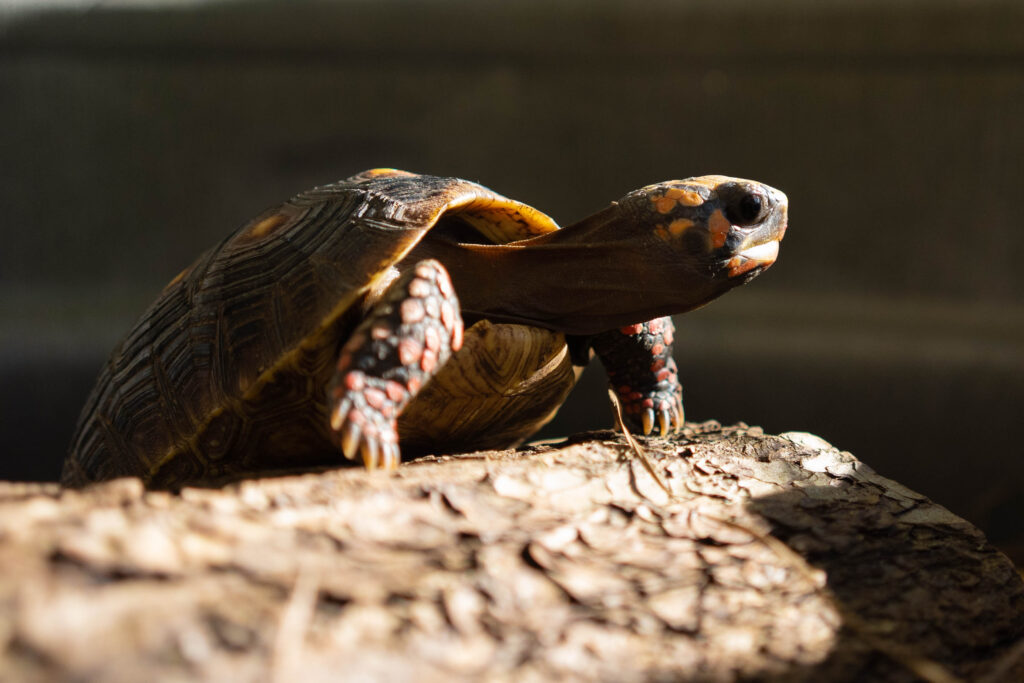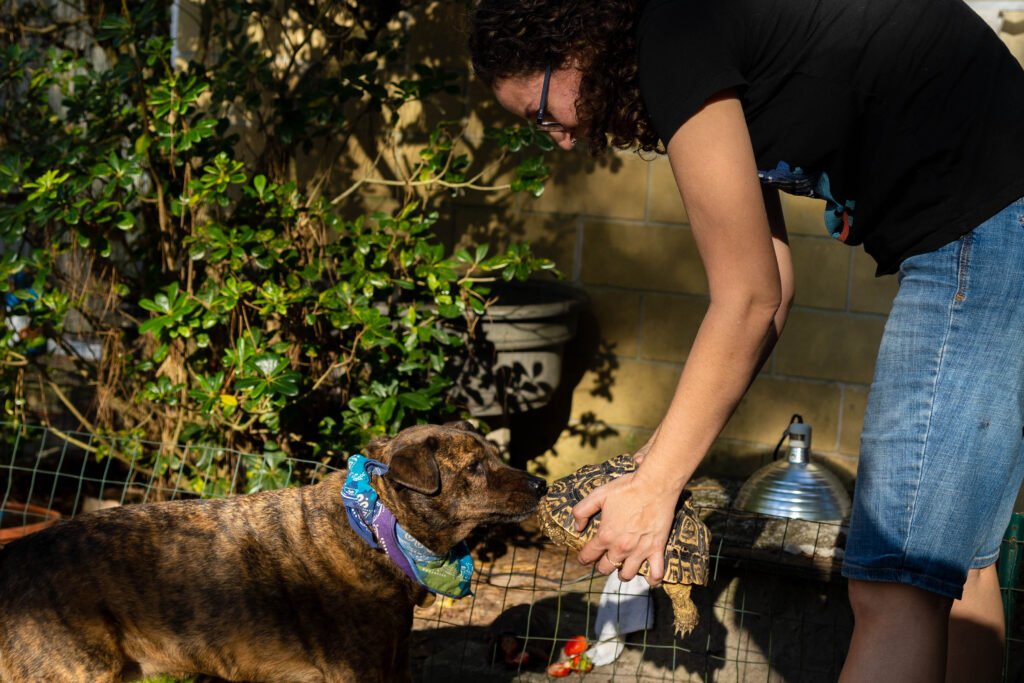Pet tortoises and their place in a changing world

Amber Sutton raises her four tortoises at her Gainesville home, three of whom live in a specially made enclosure in her backyard. She calls the creatures her shelled babies and treats them like her children.
March 4, 2022 | Story by Marlena Carrillo | Photos by Anderson Bobo
One morning in March 2021, Amber Sutton walked into her Gainesville backyard to check on her pet tortoises.
Spot, Null and Stimpy live in a crescent-shaped enclosure nestled against the wall of Sutton’s house, dug about one foot deep with an adorning hut, a tree and a concrete eating surface inside. Her fourth is a Grenadian red-footed tortoise who has yet to be named; for now, she goes by Grenada and lives inside Sutton’s home, rather than in her backyard with the others.
Sutton calls her tortoises her shelled babies. A volunteer at Ashton Biological Preserve, a conservation facility for reptile and amphibian species – including endangered tortoises – she helped dig up Spot and Null when they were just eggs. Her dog Coffee adores the three pets; she calls them “his tortoises” as if he’s taken them under his metaphorical wing.
She checks on the outdoor creatures multiple times per day, bringing them fresh fruits and vegetables to eat. On this day, she went outside to find Spot and Null, both leopard tortoises, accounted for. Stimpy, her Bolivian red-footed tortoise, however, was missing.
Sutton panicked. She dug through the pine straw in the corner, an ideal hiding spot, but found nothing.
Spot is a bulldozer; the enclosure’s wire had a couple of broken bars. Though Sutton didn’t think Stimpy could fit through the gap, the evidence left her assuming the worst. Stimpy had escaped.
Sutton felt like a parent who lost her toddler in a grocery store. She dove into action, looking through the enclosure again with her boyfriend and finding nothing. She took the tortoise’s picture and description to the Gainesville Pet Finder Facebook group, sent it to her neighbors and set out romaine lettuce and strawberries — Stimpy’s favorites.
Sutton walked outside every two or three hours hoping for her return.
The next morning, Sutton ransacked the enclosure again: no Stimpy. Later in the day, Sutton went outside to feed the remaining tortoises.
Sitting contentedly above the pile of pine needles red-handed – or red-footed – was Stimpy.
Stimpy hadn’t left at all. She had burrowed into the ground for the first time in her five or six years of life. Sutton picked Stimpy up, cradled her and yelled at her.

Stimpy, a young red-footed tortoise, has a penchant for fruits and vegetables. She eats strawberries, her favorite, while nestling the fruits under her feet protectively.
Losing a child is serious business for a parent. That’s how tortoise owners feel about their pets.
Unlike a cat or dog, however, tortoises don’t wear collars with phone numbers on them and get rushed home by a concerned citizen. People don’t usually know much about tortoises like they know other pets, and tortoises face a lot of challenges when encountering the outside world alone.
Chase Pirtle is the animal care specialist and habitat manager at Ashton, where Spot and Null lived until they hatched and Sutton asked to keep them. Pirtle calls tortoises “your passive reptile.” While lizards and snakes are revolting to many, tortoises tend to be agreeable for the non-reptile lovers of the world – you don’t often hear of people with a tortoise phobia.
Tortoises are actually a lot like dogs: they run up to visitors excitedly, respond to their names and even wiggle happily when they receive shell scratches. When Sutton was a tortoise trainer at the Santa Fe College Teaching Zoo, an enrichment study found that their Galápagos tortoises preferred to interact with humans instead of toys and other alternatives.
But due to their shells and similar appearance, they are often confused with turtles. While all tortoises are in the same category as turtles, tortoises live exclusively on land. Turtles, on the other hand, often live in water as well.
Pirtle says tortoises can be told apart from turtles by their feet: tortoises have rugged feet like elephants, while turtles’ feet are often webbed for swimming. The distinction matters – it’s common to see a video on the internet of a well-meaning individual returning a tortoise to a river, not realizing it isn’t a turtle and cannot swim.
Pirtle uses this as an example of how tortoises are at risk due to human ignorance. Like bird owners, tortoise owners tend to be highly specialized compared to other pet owners; the animals have specific diets, habitats and require very different levels of attention. While dogs and cats can roam freely in their homes, for example, birds are at a higher risk of injury or escape if they do so. Tortoises similarly require a kind of care that might seem unusual to the typical pet owner.
Browsing pet shoppers might be able to walk into a store and take home a hamster on a whim, but there’s a lot at stake in owning a tortoise – they can live from 80 to 120 years depending on the species and care they receive.
Baby tortoises can start at a couple of inches in length and grow to weigh hundreds of pounds. At full size, some can breach concrete walls and dig about 40 feet below ground.
But in the wild, they are in danger. They can drown if they are put in the water. They frequently get hit by cars. And their genetic uniformity makes them susceptible to diseases, Pirtle says.
A special part of owning tortoises is their community; Pirtle calls it their fanbase. On Facebook and beyond, countless groups are dedicated to the shelled creatures, rehoming them, caring for them and — in the most tear-jerking instances — reuniting them with their proper homes when lost.
Lost and Found Tortoises and Turtles of Florida is one such group. Lose a tortoise? You can post a picture and the location it was lost in. Find a tortoise? You can do the same. The group works to assemble these pieces until the pets can be returned to their respective families.
Viola Posley and Irene Gaz run the Facebook page. Posley, a clinical social worker with a passion for tortoises on the side, uses the group as an opportunity to help lost tortoises get found and share information about how to care for them properly.
Lost tortoises can often be defenseless against the outside world if they aren’t accustomed to it. With the combined threat of vehicles, disease and drowning, every second a tortoise spends without a proper home could be dire. The biggest threat, Pirtle says, is a lack of awareness.
If you find a 50-pound Labrador retriever in your backyard, you probably know to check for a collar and take it to your local shelter. But if you find a 50-pound tortoise with a giant shell munching through your vegetable garden? You’ll probably deposit it to the nearest uninhabited area or let it disappear on its own.
Pirtle says tortoises are a great starting point for learning about nature. He uses some of the tortoises at the preserve to introduce the animals to tour groups. Visitors are often shocked to learn they can be so outgoing.
“They think they’re going to be like hermit crabs,” Pirtle says. “They’re all different, and they all have their own individual personality.”
While many people might only be familiar with tortoises from fables and children’s books, Pirtle believes the imagery might actually help spread awareness about the creatures.
“When you look at movies and old tales and stuff, the tortoise is usually the old, wise individual,” he says. “It kind of fits that profile as well within society.”

Sutton’s youngest red-footed tortoise, a Grenadian one, has yet to be named. For now, Sutton calls her Grenada.
One of the biggest growing obstacles for tortoises in the outdoor world is habitat encroachment, Pirtle says. Florida in particular is a heavily developing state, and corporations often buy land that sits on top of burrowing tortoises.
With incidental take permits, or ITPs, corporations could be legally excused from displacing or killing endangered species listed under the Endangered Species Act. From 1993 to 2007, Florida buried 104,000 tortoises alive by development.
Tortoises can remain underground for six months to one year before they starve or run out of oxygen.
“That’s just a terrible way for anything to go out,” Pirtle says.
The state banned ITPs in 2007, but about 3,000 companies were allowed to keep their permits and continue entombing tortoises, making the number of entombed tortoises in the last 15 years unclear.
Loopholes remain for corporations to continue harming tortoises, Pirtle says. He is working to change legislation so they can coexist with the natural world. Until then, the risks for tortoises in nature continue to grow.
In addition to the plight faced by wild tortoises, a new one is emerging for pets.
The United States Association of Reptile Keepers is calling attention to recent attempts in Congress to modify the Lacey Act, a law that governs the trafficking and sale of wildlife, fish and plants. The proposed amendments would reinstate a ban of moving any species labeled “injurious” across state lines, including tortoises. A species can be labeled injurious, or potentially harmful to the economy and natural resources, just for being able to survive in a different area of the United States than where it currently lives.
The modifications wouldn’t just ban the sales of these animals across state lines – it would prevent transporting them at all. If Sutton moved a state over to Georgia, she would be forced to leave her tortoises behind. If Stimpy needed veterinary care from outside of Florida, she would be unable to access it.
This may leave tortoises vulnerable wherever you put them, be it in the wild or in their own sheltered backyard. Now more than ever, tortoises need responsible and knowledgeable caretakers to protect them.
Sutton’s strongest tortoise-owning strategy is being prepared for the future, no matter what it might bring.
“You can’t buy something that’s going to stay small and not have a plan for it when it gets big,” she says.
Sutton’s life plan for her tortoises even surpasses her own. She admits her tortoises will probably outlive her. She plans for this, too – she’ll pick them up when she can and train them to enter the house at her instruction when she can’t.
No matter how hard tortoise owners try, Sutton says they will always find a way to escape. It’s hard to be a conscientious tortoise neighbor when you don’t know what to look for, but she suggests simply being aware of your surroundings – and what’s out of place.
“What do you have in your yard every day? What looks normal and what doesn’t look normal?” Sutton says. “Or just start keeping your eye out for somebody who’s having a meltdown and putting up flyers.”

Sutton’s dog, Coffee, sniffs Null affectionately. They get along like family. Sutton jokes that the tortoises are “his tortoises” because Coffee looks after them like his own.
A year after Stimpy’s great escape, Sutton ushers her three outdoor creatures inside. In a Rubbermaid tub nestled in blankets, they combat the final throes of winter by soaking up the indoor warmth. They are snuggled up to one another by morning. Idealistic as it sounds, Sutton likes to believe they cuddle.
Stimpy probably won’t escape her watch again. Sutton will continue to reward her with lettuce and strawberries. Like any loving mother, she will care for them all the way.

Marlena Carrillo
Marlena Carrillo is an assistant editor with Atrium. She previously interned for Irving Publications, where she wrote for Giggle and Wellness360 magazines. She has also reported for WUFT and the Independent Florida Alligator. When Marlena is not writing, she is guzzling chai lattes, caring for her plants and being an avid Black Widow fan.